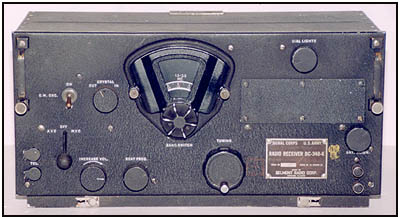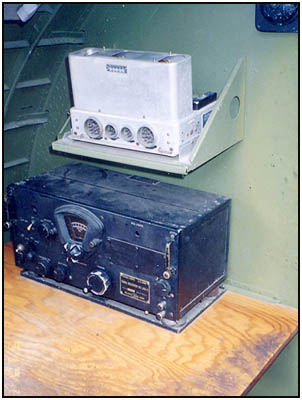Of Old Radios And Related Items--Published Monthly
The Irrepressible BC348 Receiver
BY LOUIS L. D'ANTUONO, WA2CBZ
Web Edition
Though a quite commonplace military receiver, the BC-348 still captures the imagination, especially because of its use in the World War II aircraft, the B-17. Louis D'Antuono's article inspired staff member Dave Crocker to contact the nearby Collings Foundation, dedicated to restoring such historic aircraft, for even more information. (Editor)
Webster's Unabridged Third New International Dictionary of the English Language defines "irrepressible" as "impossible to repress, restrain or control." This description fits the BC348 receiver, shown in Figure 1, perfectly. Of all the receivers I have ever known, this one has lasted the longest in the public imagination. I have always liked these units. Why, I do not know exactly.

Figure 1. The World War II BC-348 receiver.
Maybe it's the variable light brightness knob. Possibly the large tuning knob. Or perhaps the multiple frequency dial where all the bands are masked, except the one in use. It could be its rugged appearance. Or better yet, the noise limiting circuit where a potentiometer is ganged to the main tuning capacitor and progressively engages as the frequency increases. Lastly, maybe its use in the Flying Fortress B17 bomber is its greatest appeal.
Figure 2 shows the radio compartment of a restored B-17. This aircraft, named for the original Nine-O-Nine, was restored under the auspices of the Collings Foundation located in Stow, Massachusetts. A view of the B-17 in flight is shown on the opposite page, along with some facts about this famous aircraft.
I cannot go a month without seeing an ad in Antique Radio Classified or Electric Radio for information on this receiver. A year ago, I answered a request from a Ham in Georgia who wanted a schematic for a BC-348O model. Even veterans who were in the Air Corps during World War II and later are interested in purchasing one of these receivers, possibly to relive their armed services experierce.
I have owned two of these receivers in the past. One was a Q model with a builtin power supply, and the other an R model. Regrettably, I have sold both these units. When I realized how much interest there is in them, I decided it was time to write about them.
A factor in the continuing interest in these receivers is in the large number that were built. Also, they were produced by different manufacturers, who designated their particular models with a letter suffix. There are also differences among these models electrically, but the greatest difference is in the "Q" model, which has its B-connection above chassis ground. Some examples of the letter designators used to identify versions of the BC-348 and its manufacturers are provided in the following:
Version BC-348E, H, K-M, O, P, R, S were manufactured by Belmont Radio and Stromberg-Carlson; Versions BC-348J, N, Q were manufactured by Wells Gardner.
These radios are single conversion types with two RF stages, a local oscillator, a mixer, three IFs, BFO, detector, and audio output and mixer stages, an audio amplifier stage, a detector, and BFO. The frequency range of 1.5 to 18 MHz is covered in five bands, and a sixth band covers 190 to 500 kHz.
These receivers can be used for Amateur CW and AM reception. Many Hams over the years have contributed ideas to improve their performance, including modification for SSB reception, which left a lot to be desired. The usual complaint about the BC348 is its lack of selectivity and audio output, but even unmodified, these receivers remain popular.

Figure 2. The radio compartment in the B-17 bomber was on the forward left side of the airplane. The BC-348H receiver shown here is mounted on a shock mount but is not functional. Above the receiver is a BC-456 modulator which is part of the SCR-274-N Command set. This photo was taken aboard the B-17 "Nine-O-Nine" which is owned by the Collings Foundation of Stow, Massachusetts.
In terms of present-day availability, I have seen these receivers for sale at Hamfests or in trade magazines selling anywhere from $20 to $50 or more, depending on condition. Some are painted gray, while others are black. Often they have builtin power suppIies or outboard types, while some are unmodified and need conversion. Usually this involves rewiring the tube filaments from 24-volt operatlon to 6-volt or 12-volt operation.
Removing the original dynamotor and power resistors is part of the process. I have done this rewiring once, and it requires a minimum effort. The usual matching speaker is an LS3, which is rarer than the receiver. Outboard accessories can be used to improve performance.
Perhaps this article will increase attention to the BC348. At the moment, these receivers occupy a great deal of space in basements, attics, garages, and surplus warehouses, and they have limited use in hamshacks. Renewed attention might resuIt in higher prices for these receivers because of their collectibility.
However, a more positive effect would be their rejuvenation. Collectors might even be encouraged to design modifications to improve their performance. People who have used them in the past would applaud their restoration.
There are numerous articles past and present concerning the usefulness of the BC-348 that hobbyists can research to help them along. A list of references is included in the box below. In any event, here and elsewhere, the BC348 will remain irrepressible.
Photos: Courtesy of Dennis DuVall, via Hank Brown, and the Collings Foundation.
(Louis L. D'Antuono, WA2CBZ, 8802 Ridge Blvd., Brooklyn, NY 11209)
Louis D'Antuono holds an Extra Class Amateur radio license. He is a Social Studies teacher at the James Madison High School in Brooklyn, New York.
Sources of More Information on the BC-348
Alfonsi, Victor. "Broadcast Band Coverage for the BC-348-Q." QST, September 1949.
Armistead, Herbert K. "Servicing XTAL Filters in the BC-348." QST, August 1947.
Bernard, W.B. "More on the BC-348 Series Receivers, Modifying the BC-348-0." QST, November 1947.
Carson, George S. "Note(s) on BC-348 Receivers." QST, September 1957.
Ditton, Jack. "Double Conversion Using the BC-348." QST, June 1954.
Garnet, W. Frank. "BC-348 Alignment." QST, July 1959.
Hines, Jack G. "Modifying Tuning Range of the BC-348." QST, January 1952.
Jenkins, Kenneth. "Eliminating Backlash in BC-348 Receivers." QST, February 1949.
Kersten, Paul M. "A Further Note on the BC-348-Q." QST, November 1947.
Kersten, Paul M. "Converting the BC-348-Q." QST, January 1947.
Prescott, A.F. "Calibrating the BC-348." QST, November 1947.
Rand, Philip S. "A Q-5er for BC-348 Owners, Converting with an External Oscillator." QST, June 1948.
| [Free Sample] [Books, etc., For Sale] [Subscribe to A.R.C./Renew] [Classified Ads] [Auction Prices] [Event Calendar] [Links] [Home] [Issue Archives] [Book Reviews] [Subscription Information] [A.R.C. FAQ] URL = http://www.antiqueradio.com/Feb02_BC348.html Copyright © 1996-2002 by John V. Terrey - For personal use only. Last revised: January 28, 2002. For Customer Assistance please contact ARC@antiqueradio.com or call (866) 371-0512 Pages designed/maintained by Wayward Fluffy Publications
Antique Radio Classified |